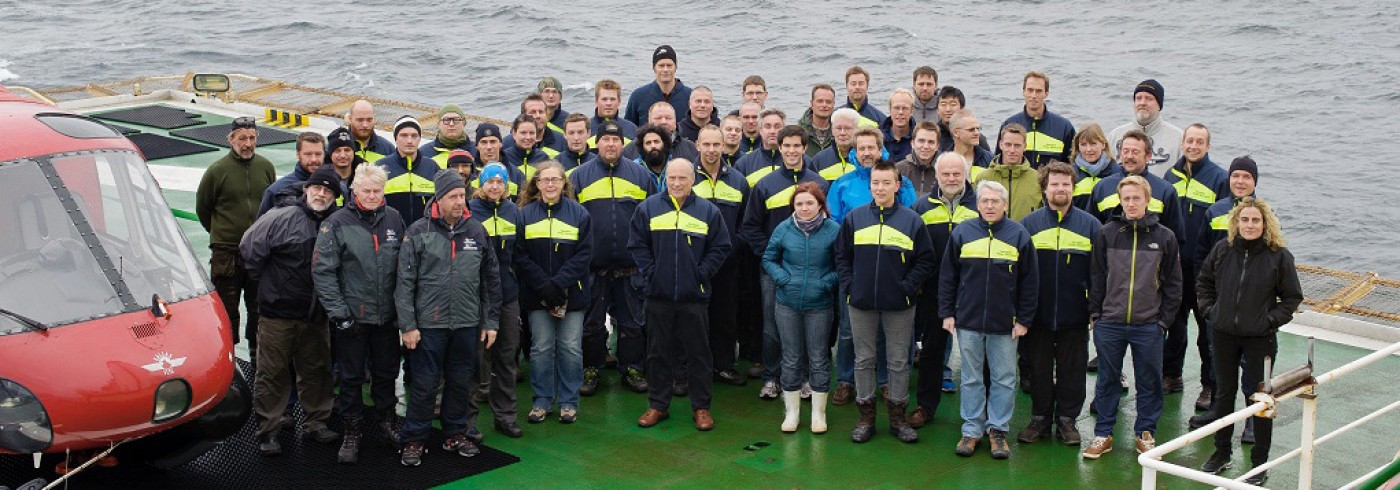Continued data acquisition within the Danish Continental Shelf Project: EAGER 2011 cruise
17 August 2011 - 10 September 2011
3D visualization of the multibeam bathymetric data acquired during the EAGER 2011 cruise. These data will be incorporated in the upcoming new version of the International Bathymetric Chart of the Arctic Ocean (IBCAO). Background bathymetric grid: IBCAO version 2.23.
During the EAGER 2011 (East Greenland Ridge) cruise on the Swedish icebreaker Oden, multibeam bathymetry, sub bottom profiler, seismic reflection and refraction profiles and gravity data were acquired to complement data acquired during the LOMROG I cruise in 2007. These mapping activities were all part of the Continental Shelf Project of the Kingdom of Denmark. We started in Longyearbyen on Svalbard on 17 August and ended at the same location on 10 September 2011.
Multibeam bathymetry data were collected continuously throughout the cruise along the 4000-nautical-mile track of Oden. Data were acquired using the SIMRAD EM 122 multibeam echo sounder installed on Oden in order to study bottom processes and seafloor morphology. In addition, sub bottom profiling was carried out continuously to characterize the stratigraphy of the upper 50–200 m of the sedimentary column. These data were acquired using the SBP120 hull-mounted 2−8 kHz chirp sonar system. Data acquisition focused on the East Greenland Ridge and the continental slope south-west of the ridge, to map the position of the foot of the slope and the 2500-m isobath. Oceanographic measurements, including CTD and water samples, were made at 16 dedicated hydrographic stations to support the multibeam bathymetric data acquisition and the analysis of the refraction seismic data. Most of the water column sampling conducted during the EAGER cruise was done using type XCTD-1 and XTB-T5 expendable probes.
Seismic data were acquired to investigate how the East Greenland Ridge is attached to the northeast Greenland Shelf. The seismic data were acquired using the same equipment that was developed for the two LOMROG cruises, though the source array was enlarged. Refraction seismic investigations used both ocean bottom seismometers (OBS) and sonobuoys. Reflection seismic data were acquired using a short streamer with an active length of 200 m. The seismic source was either a 2080-cubic-inch array consisting of four G-guns or a 1040-cubic-inch linear array consisting of two G-guns.
A total of three seismic lines were acquired: for Line 1 (125 km long), two runs were completed, so both dedicated refraction and reflection data were recorded; for Line 2 (163 km), only one run for refraction data was possible due to problems with the large airgun array; and for Line 3 two runs were possible along the 66-km-long ice-free portion of the line. Another 66-km-long segment of Line 3 was located on the ice-covered shelf off northeast Greenland, where one run was completed. Since the streamer was deployed whenever seismic data were acquired, reflection seismic data were collected on all runs, though with a variable shot interval. All 15 OBS deployments and 42 of 46 sonobuoy deployments were successful.
Gravity data were acquired along the entire track of the EAGER 2011 cruise using a gravimeter installed on Oden.
Two Danish science-of-opportunity projects were also conducted aboard Oden. One project from DTU-Food focused on collecting samples of Roseobacter populations in the Greenland Sea. Observations of birds and marine mammals were made by an ornithological observer from the National Environmental Research Institute (Aarhus University, Denmark). A Swedish ceramicist and a Faroese painter also participated in the cruise
Thanks to the favourable weather conditions, all cruise objectives were met.










